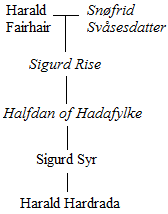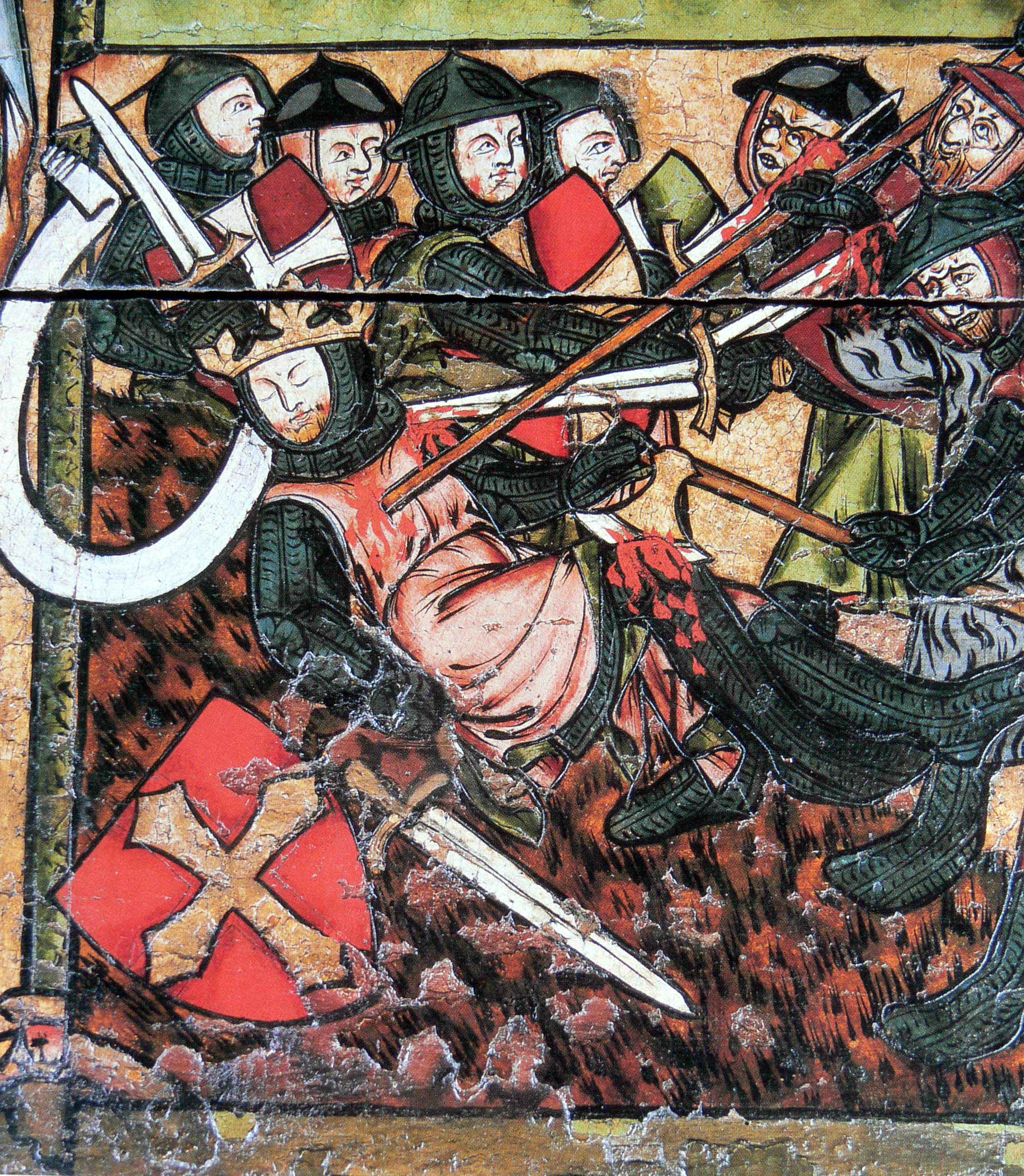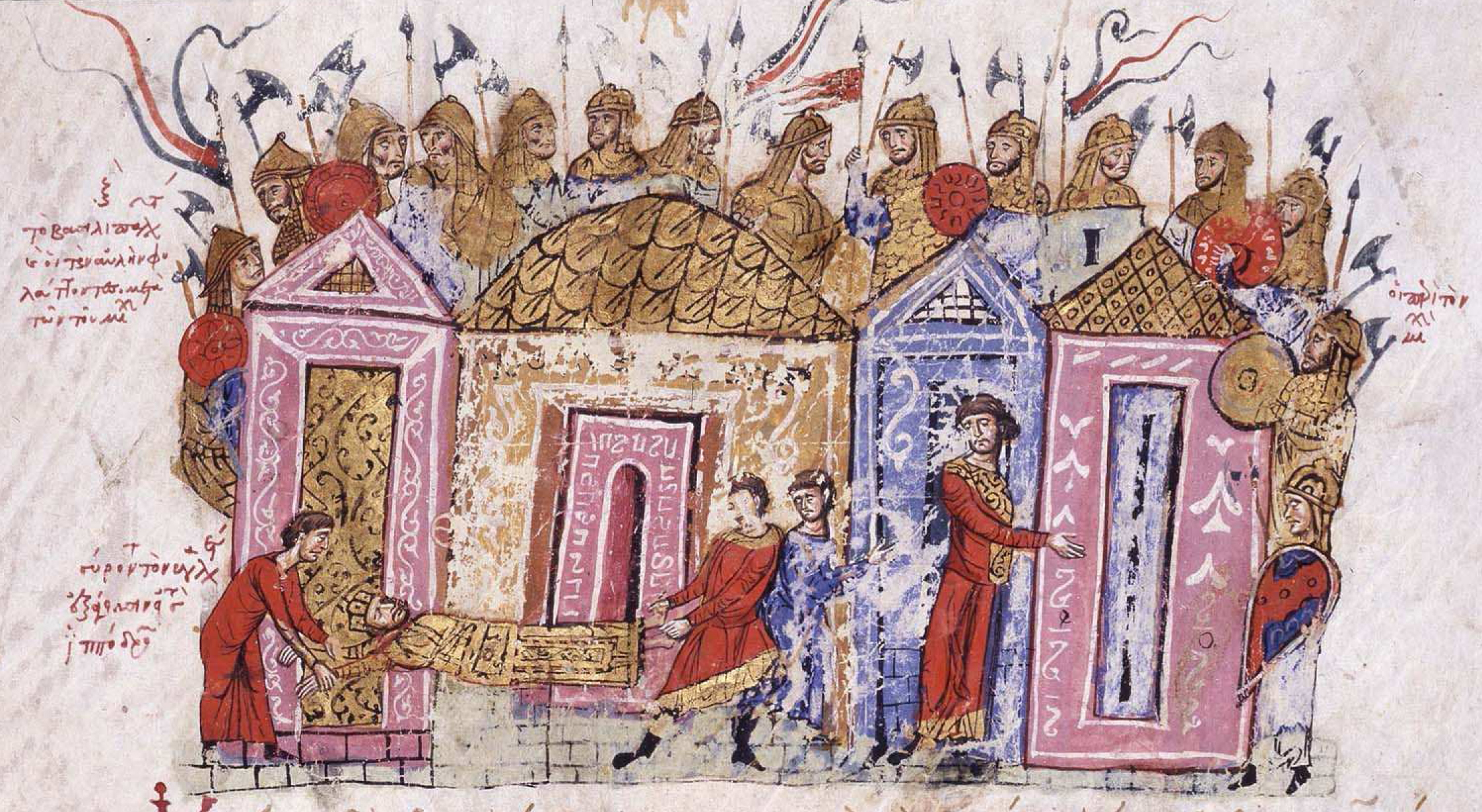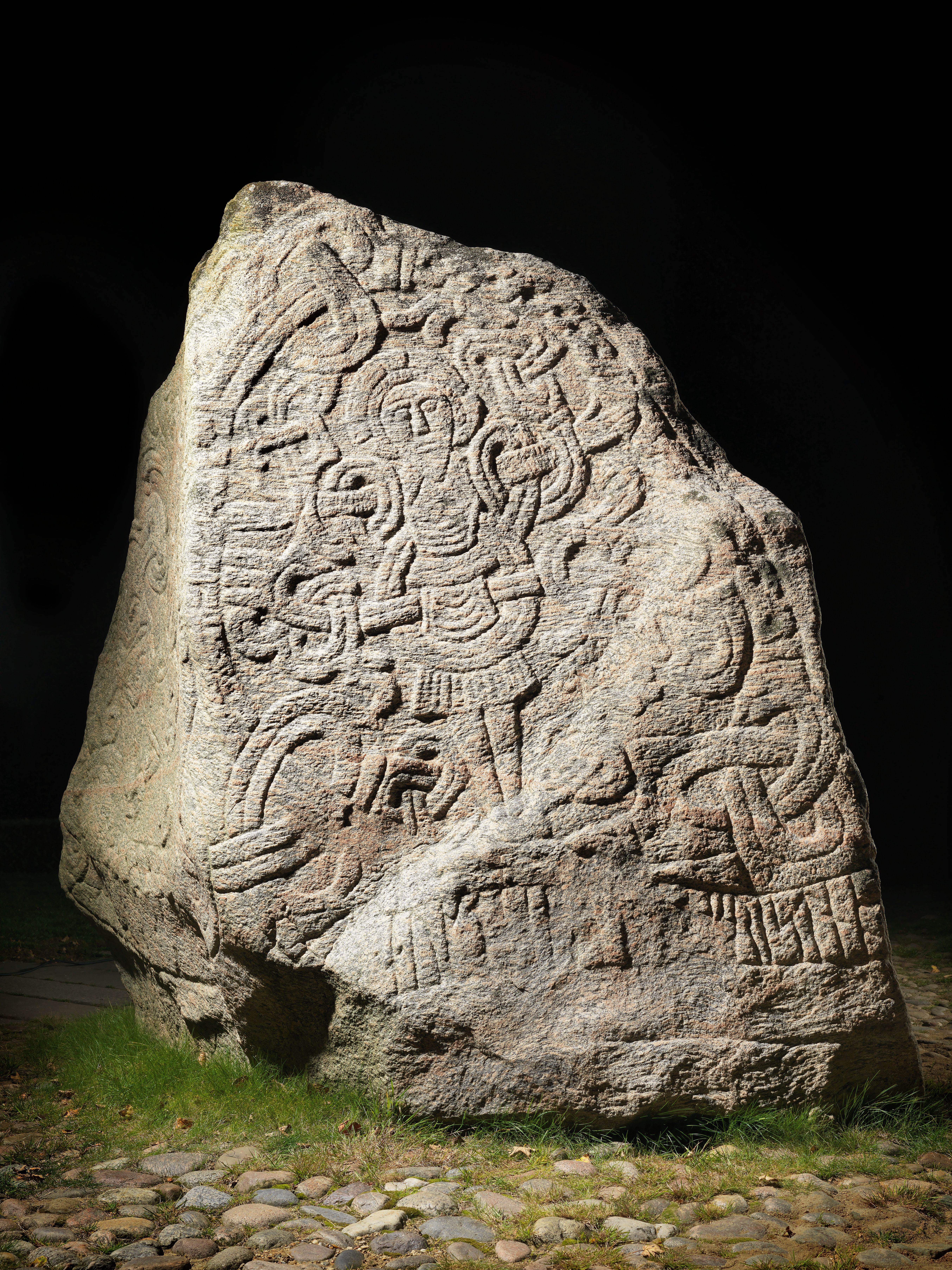|
Harald Hardråde
Harald Sigurdsson (; – 25 September 1066), also known as Harald III of Norway and given the epithet ''Hardrada'' in the sagas, was List of Norwegian monarchs, King of Norway from 1046 to 1066. He unsuccessfully claimed the Monarchy of Denmark, Danish throne until 1064 and the List of English monarchs, English throne in 1066. Before becoming king, Harald spent 15 years in exile as a mercenary and military commander in Kievan Rus' and chief of the Varangian Guard in the Byzantine Empire. In his Gesta Hammaburgensis ecclesiae pontificum, chronicle, Adam of Bremen called him the "''Thunderbolt of the North''". In 1030, the fifteen-year-old Harald fought in the Battle of Stiklestad along-side his half-brother Saint Olaf, Olaf Haraldsson. Olaf sought to reclaim the Norwegian throne, which he had lost to Danish king Cnut two years previously. Olaf and Harald were defeated by forces loyal to Cnut, and Harald was forced into exile to Kievan Rus'. Thereafter, he was in the army of Gra ... [...More Info...] [...Related Items...] OR: [Wikipedia] [Google] [Baidu] |
Edward The Confessor
Edward the Confessor ( 1003 – 5 January 1066) was King of England from 1042 until his death in 1066. He was the last reigning monarch of the House of Wessex. Edward was the son of Æthelred the Unready and Emma of Normandy. He succeeded Cnut the Great's son – and his own half-brother – Harthacnut. He restored the rule of the House of Wessex after the period of Danish rule since Cnut conquered England in 1016. When Edward died in 1066, he was succeeded by his wife's brother Harold Godwinson, who was defeated and killed in the same year at the Battle of Hastings by the Normans under William the Conqueror. Edward's young great-nephew Edgar Ætheling of the House of Wessex was proclaimed king after the Battle of Hastings, but was never crowned and was peacefully deposed after about eight weeks. Historians disagree about Edward's fairly long 24-year reign. His nickname reflects the traditional image of him as unworldly and pious. Confessor of the Faith, Confess ... [...More Info...] [...Related Items...] OR: [Wikipedia] [Google] [Baidu] |
Sigurd Syr
Sigurd Syr (Old Norse: ''Sigurðr Sýr'') (died c. 1018) was a Norwegian petty king of Ringerike, a region in Buskerud. He was notable in Norwegian history largely through his association with Kings Harald Hardrada and Olaf II of Norway. By his marriage with Åsta Gudbrandsdatter after her first husband Harald Grenske had died, Sigurd Syr was stepfather of King Olaf II and the father of King Harald III. Biography The traditional view of Sigurd Halvdansson Syr's pedigree, as presented in various Icelandic poems and historical sagas culminating in Snorri Sturluson's ''Heimskringla'', is that he was a great-grandson of King Harald Fairhair, through Harald's son Sigurd Rise. Doubt has been cast on his connection with Sigurd Rise, a relatively obscure son of Harald Fairhair by a Sami girl named Snæfrithr Svásadottir.Snorri Sturluson, ''Heimskringla: History of the Kings of Norway'', tr. Lee M. Hollander, The American-Scandinavian Foundation, Austin: University of Texas Press, ... [...More Info...] [...Related Items...] OR: [Wikipedia] [Google] [Baidu] |
Cnut
Cnut ( ; ; – 12 November 1035), also known as Canute and with the epithet the Great, was King of England from 1016, King of Denmark from 1018, and King of Norway from 1028 until his death in 1035. The three kingdoms united under Cnut's rule are referred to together as the North Sea Empire by historians. As a Danish prince, Cnut won the throne of England in 1016 in the wake of centuries of Viking activity in northwestern Europe. His later accession to the Danish throne in 1018 brought the crowns of England and Denmark together. Cnut sought to keep this power base by uniting Danes and English under cultural bonds of wealth and custom. After a decade of conflict with opponents in Scandinavia, Cnut claimed the crown of Norway in Trondheim in 1028. In 1031, Malcolm II of Scotland also submitted to him, though Anglo-Norse influence over Scotland was weak and ultimately did not last by the time of Cnut's death.ASC, Ms. D, s.a. 1031. Dominion of England lent the Danes an import ... [...More Info...] [...Related Items...] OR: [Wikipedia] [Google] [Baidu] |
Saint Olaf
Saint Olaf ( – 29 July 1030), also called Olaf the Holy, Olaf II, Olaf Haraldsson, and Olaf the Stout or "Large", was King of Norway from 1015 to 1028. Son of Harald Grenske, a petty king in Vestfold, Norway, he was posthumously given the title '' Rex Perpetuus Norvegiae'' () and canonised at Nidaros (Trondheim) by Bishop Grimketel, one year after his death in the Battle of Stiklestad on 29 July 1030. His remains were enshrined in Nidaros Cathedral, built over his burial site. His sainthood encouraged the widespread adoption of Christianity by Scandinavia's Vikings/Norsemen. Pope Alexander III confirmed Olaf's local canonisation in 1164, making him a recognised saint of the Catholic Church, and Olaf started to be known as ''Rex Perpetuus Norvegiae'' – ''eternal king of Norway''. Following the Reformation, he was a commemorated historical figure among some members of the Lutheran and Anglican Communions. The saga of Olav Haraldsson and the legend of Olaf the Saint becam ... [...More Info...] [...Related Items...] OR: [Wikipedia] [Google] [Baidu] |
Battle Of Stiklestad
The Battle of Stiklestad (; ) in 1030 is one of the most famous battles in the history of Norway. In this battle, King Olaf II of Norway () was killed. During the pontificate of Pope Alexander III, the Roman Catholic Church declared Olaf a saint in 1164. His younger half-brother, Harald Hardrada (), was also present at the battle. Harald was only fifteen when the battle of Stiklestad took place. He became King of Norway in 1047, until his death in a failed invasion of England at the Battle of Stamford Bridge in 1066. Background During the 9th century, Norway was divided between several local kings controlling their own fiefs. By the end of the century, King Harald Fairhair (Old Norse: ) managed, mainly due to the military superiority gained by his marriage alliance with Hákon Grjótgarðsson of Nidaros, to subjugate these mini–kingdoms, and he created a unified Norwegian state. This alliance came apart after Harald's death. The jarls of Lade and various descendants of Haral ... [...More Info...] [...Related Items...] OR: [Wikipedia] [Google] [Baidu] |
Adam Of Bremen
Adam of Bremen (; ; before 1050 – 12 October 1081/1085) was a German medieval chronicler. He lived and worked in the second half of the eleventh century. Adam is most famous for his chronicle '' Gesta Hammaburgensis ecclesiae pontificum'' (''Deeds of Bishops of the Hamburg Church''). He was "one of the foremost historians and early ethnographers of the medieval period". In his chronicle, he included a chapter mentioning the Norse outpost of Vinland, and was thus the first European to write about the New World. Life Little is known of his life other than hints from his own chronicles. He is believed to have come from Meissen, then its own margravate. The dates of his birth and death are uncertain, but he was probably born before 1050 and died on 12 October of an unknown year (possibly 1081, at the latest 1085). From his chronicles, it is apparent that he was familiar with a number of authors. The honorary name of ''Magister Adam'' shows that he had passed through all the s ... [...More Info...] [...Related Items...] OR: [Wikipedia] [Google] [Baidu] |
Gesta Hammaburgensis Ecclesiae Pontificum
(Medieval Latin for "Deeds of the Bishops of Hamburg") is a historical treatise written between 1073 and 1076 by Adam of Bremen, who made additions (''scholia'') to the text until his death (possibly 1081; before 1085). It is one of the most important sources of the medieval history of Northern Europe, and the oldest textual source reporting the discovery of coastal North America. It covers the entire period known as the Viking Age, from the foundation of the bishopric under Willehad in 788 until the rule of prince-bishop Adalbert in Adam's own time (1043–1072). The text focuses on the history of the Hamburg-Bremen diocese and its bishops. As the bishops had jurisdiction over the missions to Scandinavia, it also gives a report of the Norse paganism of the period. The existence of the work was forgotten in the later medieval period, until it was re-discovered in the late 16th century in the library of Sorø Abbey, Denmark. Contents The treatise consist of the followin ... [...More Info...] [...Related Items...] OR: [Wikipedia] [Google] [Baidu] |
Byzantine Empire
The Byzantine Empire, also known as the Eastern Roman Empire, was the continuation of the Roman Empire centred on Constantinople during late antiquity and the Middle Ages. Having survived History of the Roman Empire, the events that caused the fall of the Western Roman Empire in the 5th centuryAD, it endured until the fall of Constantinople to the Ottoman Empire in 1453. The term 'Byzantine Empire' was coined only after its demise; its citizens used the term 'Roman Empire' and called themselves 'Romans'. During the early centuries of the Roman Empire, the western provinces were Romanization (cultural), Latinised, but the eastern parts kept their Hellenistic culture. Constantine the Great, Constantine I () legalised Christianity and moved the capital to Constantinople. Theodosius I, Theodosius I () made Christianity the state religion and Greek gradually replaced Latin for official use. The empire adopted a defensive strategy and, throughout its remaining history, expe ... [...More Info...] [...Related Items...] OR: [Wikipedia] [Google] [Baidu] |
Varangian Guard
The Varangian Guard () was an elite unit of the Byzantine army from the tenth to the fourteenth century who served as personal bodyguards to the Byzantine emperors. The Varangian Guard was known for being primarily composed of recruits from Northern Europe, including mainly Norsemen from Scandinavia but also Anglo-Saxons from England. The recruitment of distant foreigners from outside Byzantium to serve as the emperor's personal guard was pursued as a deliberate policy, as they lacked local political loyalties and could be counted upon to suppress revolts by disloyal Byzantine factions. The Rus' people, Rus' provided the earliest members of the Varangian Guard. They were in Byzantine service from as early as 874. The Guard was first formally constituted under Emperor Basil II in 988, following the Christianization of Kievan Rus' by Vladimir I of Kiev. Vladimir, who had recently taken control of Kiev with an army of Varangian warriors, sent 6,000 men to Basil as part of a military ... [...More Info...] [...Related Items...] OR: [Wikipedia] [Google] [Baidu] |
Kievan Rus'
Kievan Rus', also known as Kyivan Rus,. * was the first East Slavs, East Slavic state and later an amalgam of principalities in Eastern Europe from the late 9th to the mid-13th century.John Channon & Robert Hudson, ''Penguin Historical Atlas of Russia'' (Penguin, 1995), p.14–16. Encompassing a variety of polities and peoples, including East Slavs, East Slavic, Norsemen, Norse, and Finnic peoples, Finnic, it was ruled by the Rurik dynasty, founded by the Varangians, Varangian prince Rurik.Kievan Rus , Encyclopædia Britannica Online. The name was coined by Russian historians in the 19th century to describe the period when Kiev was preeminent. At its greatest extent in the mid-11th century, Kievan Rus' stretched from the White Sea in the north to the Black Sea in the south and from the River source, headwaters of the ... [...More Info...] [...Related Items...] OR: [Wikipedia] [Google] [Baidu] |
List Of English Monarchs
This list of kings and reigning queens of the Kingdom of England begins with Alfred the Great, who initially ruled Wessex, one of the heptarchy, seven Anglo-Saxon kingdoms which later made up modern England. Alfred styled himself king of the Anglo-Saxons from about 886, and while he was not the first king to claim to rule all of the English people, English, his rule represents the start of the first unbroken line of kings to rule the whole of England, the House of Wessex. Arguments are made for a few different kings thought to have controlled enough Anglo-Saxon kingdoms to be deemed the first king of England. For example, Offa of Mercia and Egbert of Wessex are sometimes described as kings of England by popular writers, but it is no longer the majority view of historians that their wide dominions were part of a process leading to a unified England. The historian Simon Keynes states, for example, "Offa was driven by a lust for power, not a vision of English unity; and what he ... [...More Info...] [...Related Items...] OR: [Wikipedia] [Google] [Baidu] |
Monarchy Of Denmark
The monarchy of Denmark is a constitutional institution and a historic office of the Kingdom of Denmark. The Kingdom includes Denmark proper and the autonomous territories of the Faroe Islands and Greenland. The Kingdom of Denmark was already consolidated in the 8th century, whose rulers are consistently referred to in Frankish sources (and in some late Frisian sources) as "kings" (). Under the rule of King Gudfred in 804 the Kingdom may have included all the major provinces of medieval Denmark. The current unified Kingdom of Denmark was founded or re-united by the Viking kings Gorm the Old and Harald Bluetooth in the 10th century. Originally an elective monarchy, it became hereditary only in the 17th century during the reign of Frederick III. A decisive transition to a constitutional monarchy occurred in 1849 with the writing of the first democratic constitution, replacing the vast majority of the old absolutist constitution. The current Royal House is a branch of th ... [...More Info...] [...Related Items...] OR: [Wikipedia] [Google] [Baidu] |










